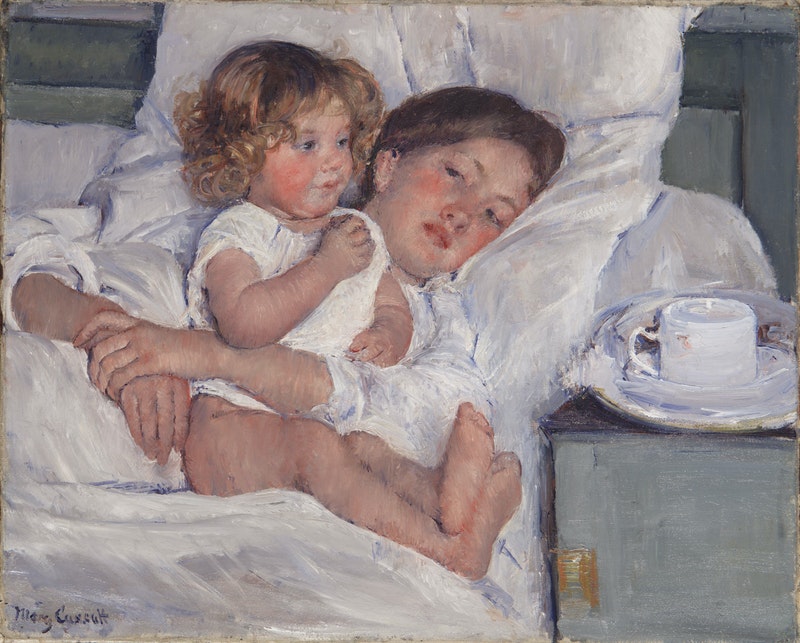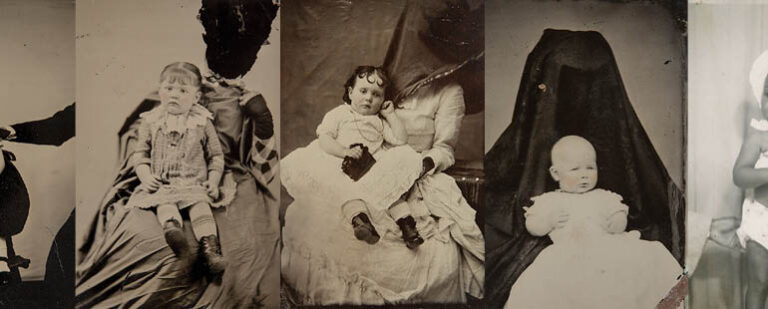The Maternal Vision of Leslie Jamison and Marilynne Robinson

In the earliest years of parenting, when the work of care demands so much from a mother’s body, mind, and time, it can be difficult for a writer to protect the rigor and quiet required to create something innovative and true, or to muster the moxie required to publish her work. The tensions between motherhood and artistic practice can feel insurmountable.
Yet there are ways in which motherhood and the writing life are uniquely compatible. In a 2020 essay in the New York Review of Books titled “Other Voices, Other Rooms,” Leslie Jamison writes, “Being with my baby every hour of every day demanded close attention, not just to her . . . but also to everything else, because the alternative to paying attention was growing bored out of my mind. My hunger for stimulation meant my gaze was sensitized, the way your eyes can see more after you’ve spent a few minutes in the dark.” Habits of attention are essential to the cultivation of the authorial mind. The ability to attend to ordinary moments—to gesture, tenor, and color—furnishes the writer with found material. The more a writer sees, the more she has to show her reader. A writer’s attention forms her narrative vision, or the aesthetic and moral sensibility with which we are guided through the world of a text. It shapes the constellation of details that the narrator notices, remembers, and trains us to see.
Vision is a theme in the work of Marilynne Robinson, novelist and mother. And I can’t help but wonder if Robinson’s interest in this theme, and the enthralling vision of her narrators, flow from the kind of maternal attention that Jamison describes.
In Gilead, Robinson’s Pulitzer-winning novel from 2004 and the first in a series of the same name, the narrator delights in habits of attention. John Ames’s eye is drawn to simple beauty, and he renders these sights with poetic detail: “I saw a bubble float past my window,” he writes, “fat and wobbly and ripening toward that dragonfly blue they turn just before they burst.” The book unfolds as a letter that Ames, an old man nearing death, writes to his six-year-old son. Often, the small wonders that cross his vision cause him to erupt in awe: “How I have loved this life”; “Oh, I will miss the world!” When the scale of one’s attention becomes fixed on the small, the way Jamison’s did as she studied her baby’s eyelids and discerned the timbres of her cries, even a tiny globe of soap becomes a world unto itself.
In a 2020 interview with The Trinity Forum, Robinson was asked how the experience of motherhood impacted her writing, particularly her observations of beauty. “The whole motherhood thing is very pleasing to me,” she answered. “There is probably nothing more interesting than watching language develop in someone, watching memory and narrative ex nihilo emerge in these fantastic little brains . . . If I had to choose between every other aspect of my life or being a mother, I would be a mother.” Robinson observed her own children with rapt attention, likely becoming more attuned to the fine grain of the world’s detail. And in her reverence for “these fantastic little brains,” perhaps she began, herself, to behold the world with the mind of a child, for whom everything is new.
Certainly, in Ames, she’s developed a character who possesses childlike wonder. “Each morning I’m like Adam waking up in Eden,” he writes, “amazed at the cleverness of my hands and the brilliance pouring into my mind through my eyes.” Since boyhood, Ames has had a unique ability to notice. He recalls being enchanted by a lunar marvel while on a journey as a child with his father. He interrupts his father to show him the peculiar quality of the light, and his father replies, “I would never have thought this place could be beautiful. I’m glad to know that.”
In “Other Voices, Other Rooms,” Jamison suggests that “art asks us to briefly abandon our lives in order to come back with a changed gaze,” and one of the great virtues of Robinson’s novels is the way they alter our vision. Ames trains us, as he trained his father, to notice light. His attention is fixed on sunshine, fire, moonlight, fireflies. He notices “a shimmer on a child’s hair, in the sunlight. There are rainbow colors in it, tiny, soft beams of just the same colors you can see in the dew sometimes.” He remembers the quality of the glow on his wife’s skin when she was baptized, how she lifted her face “into winter morning light, new-snow light.” When I have seen the world awhile through Ames’s eyes, I become newly aware of the light in my own world—its cheering presence, its variety of expression. Narrative vision shaped by maternal attention shows me more of the world than I had seen before.
Robinson’s sensitized gaze also helps me to see beyond timeworn dichotomies and simplistic ideologies, and to behold the world’s complexity. For all of his attention to light, Ames does not fear darkness. As a widower, before he was surprised to begin again with a wife and child, he’d walk through Gilead at night, praying for the families in every darkened house. He’d sit in the church in the dark, waiting for the sun to rise. One might find “a certain crepuscular quality in me,” he reflects, and he recalls his loneliness, felt acutely in those dim hours, as a gift. “It seems to me that in all that deep darkness a miracle was preparing.” Robinson does not equate light with goodness and darkness with evil. Through her narrative vision, we attend to the darkness and, rather than finding it fearsome, find it is full of possibility. This has relational implications, for it clarifies our vision not only of bubbles and dew, but of the people in our lives—even those we most struggle to love.
In Jack, the fourth and most recent novel of the Gilead series, Robinson expands her exploration of darkness as she shows us the world through Jack Boughton’s eyes. A self-loathing and deeply lonely man, Jack avoids the light. “Exposure was one of his greatest fears,” the narrator explains, with a privileged third-person view into Jack’s mind. Jack slinks from daylight into shadows and is soothed to step from lamplit streets into pitch dark vestibules. “I have been one acquainted with the night,” begins Jack’s favorite poem. Those acquainted with the night: thieves, insomniacs, drunks—all words Jack uses to describe himself. Also acquainted with the night: mothers.
Mothers know deep darkness, and they know that darkness can be the nesting ground of intimacy and private joy. As Jamison writes, “My baby opened a seam in the night and pulled me into the strange dark world beyond.” In the darkest hours, a mother might feed her child, barely seeing, reveling in flesh on flesh. And when a mother looks upon even the darkest, most deviant of her children, she sees promise, beauty, sparks.
It is with this maternal sensibility that Robinson renders Jack’s complex protagonist. If we heard Jack described in broad brush, we’d likely judge him harshly. But through Robinson’s gaze, we see more. We see Jack’s tenderness as he forges a profound intimacy, in the privacy of darkness, with a woman named Della Miles. And through Della’s eyes, we see straight to Jack’s soul. “A soul has no earthly qualities,” Della says, “no history among things of this world, no guilt or injury or failure. No more than a flame would have. There is nothing to be said about it except that it is a holy human soul.” With the love of a mother, Robinson trains our gaze to see Jack, and all human persons, as pure, luminous, utterly forgiven.
Leslie Jamison’s own writing is marked by profound reverence for the human person. We might trace the development of her narrative vision from the twelve-step programs, where she became enamored of the mundane details animating stories swapped between people experiencing substance use disorder, to the labor of motherhood, which deepened her reverence for the human body and the profound dignity of the individual. “In a way I hadn’t realized,” Jamison writes in “Other Voices, Other Rooms,” “recovery had been training me for parenthood—patiently teaching me that an experience can be utterly common and still absolutely profound.”
Chronicled in her 2018 memoir The Recovering, Jamison’s fight for sobriety honed her attention to the beauty of the banal. This attention illuminated the page, as she rendered simple pleasure or ordinary hurt in lyric detail. In The Recovering, she recalls an afternoon among friends “with cold beers and a warm breeze, eating whole fish roasted over flames, swimming in a volcanic basin with ribbons of chilly water and hot water swirled together like scarves.” While the volcanic basin may be extraordinary, Jamison’s narrative vision draws our eye to the elemental—fish and fire and water—which she endows with poetic dignity. Elsewhere she notices a sunset—a quotidian event—with something like rapture: “The gloaming was like wine itself, with a certain thickness and sweetness, getting into my blood and humming through me.” The elevated diction of “gloaming” and the sensual language of “thick” and “sweet” and “humming” turn the sun’s daily descent into something ecstatic. For years now, Jamison’s writing has been charged with awe.
Then her daughter was born, and the monotony and smallness of maternal obligation heightened her attention even more than recovery had. This clarified vision for the fine weave of experience is evident in a 2020 essay in Vogue in which Jamison writes about losing her sense of smell after she contracted COVID-19. She is “taunted by clementine oranges and cookie dough and peanut butter and lilies and green-apple dish soap,” and by “plain yogurt, Windex, the stink of my daughter’s diaper bin when I’d forgotten to empty it.” Even the unpleasant smells “were part of being in the world, part of being implicated in it and addressed and gloriously invaded by it.” Jamison’s narrative vision, sharpened in motherhood, draws our eye (and nose) to domestic detail. Her list of olfactory pleasures, enumerated with parataxis, evokes a sense of abundance, and this trains us to see the extravagance available to us in every moment. The word “glorious” evokes religious devotion, which she underscores in her concluding sentence: “the simplest pleasures” she writes, are “utterly ordinary and holy as incense in church, something offered to the gods.”
In a recent interview with ArtNet, Jamison notes another way that motherhood has changed her narrative vision. The work of care—daily exchanges of tenderness in the wipe of a nose or a brush of soap behind the ear—sensitized her to gestures of care shared between strangers every day. It deepened her reverence for the human body, and this, she says, directly informs her recent writing. In late 2020, Jamison wrote an essay for The New York Times Magazine about bathhouses, or hammams, in Manhattan and Istanbul. In the baths, Jamison celebrates “the tattooed hipster with a handlebar mustache who dunked his head under the icy water” and “the impossibly thin old woman who looked like a once-ballerina or a once-junkie, her skin steaming in the darkness.” She notices “our bodies shrugging and sighing, our toes curled and our foreheads beaded, our bodies leaking tears of ache and release.” In the baths, strangers are “subjects of pleasure, tender animals, hungry for care and touch, all of us lying side by side in the radiant heat.” This corporeal prose fixes our gaze on the complexity and beauty of strangers. On their faces, Jamison sees “hidden layers of wariness and fragility” and “sudden pockets of joy.” These phrases recall a passage in John Ames’s letter: “Any human face is a claim on you, because you can’t help but understand the singularity of it, the courage and loneliness of it.” The narrative vision of both Jamison and Robinson places “all of us”—the reader included—“side by side.” Both writers invite us to see the lives of others not as suspect, pitiable, or banal, but as infinitely interesting, noble, worthy of our study. Here, the moral implications of narrative vision come into focus. “You deserve to be touched,” Jamison writes. You are “a holy human soul,” Della says of Jack. To regard the world with such close attention, to behold sunlight and peanut butter and the diaper bin as holy, trains our eye to see even strangers with extraordinary love.
At the bathhouses on East 10th Street in Manhattan, Jamison and her friends retreat from “the hourly exhaustion of taking care of children” and speak about “the guilt and weariness and gratitude of showing up for work and motherhood; and never having enough of ourselves to do justice to either one.” Jamison feels the tension between the labor of care and the labor of writing. But as she persists in both vocations, her maternal attention enriches her narrative vision, and, like Robinson, she offers readers the gift of a humanized gaze.


